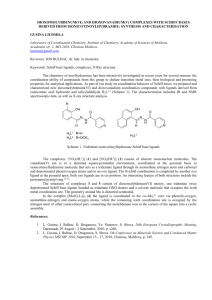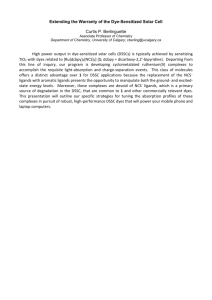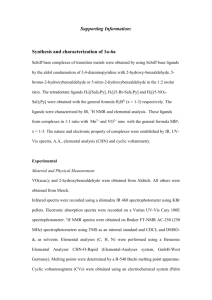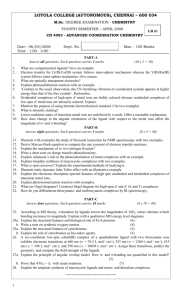1 For the past few decades, ... reactions are among the most ...
advertisement
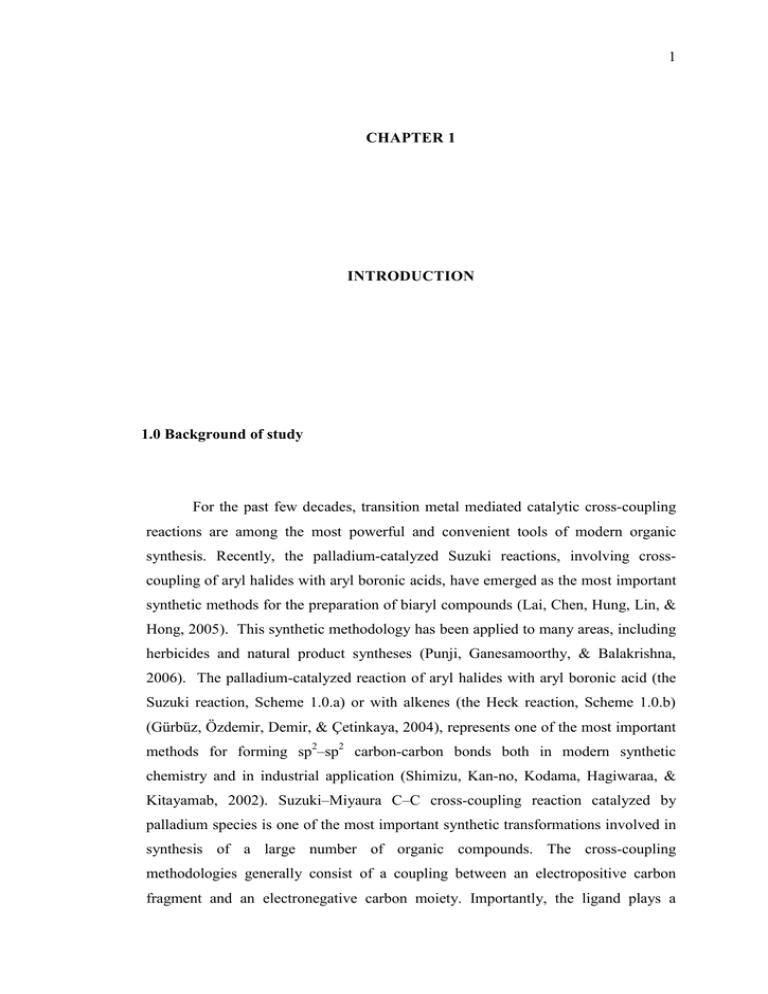
1 CHAPTER 1 INTRODUCTION 1.0 Background of study For the past few decades, transition metal mediated catalytic cross-coupling reactions are among the most powerful and convenient tools of modern organic synthesis. Recently, the palladium-catalyzed Suzuki reactions, involving crosscoupling of aryl halides with aryl boronic acids, have emerged as the most important synthetic methods for the preparation of biaryl compounds (Lai, Chen, Hung, Lin, & Hong, 2005). This synthetic methodology has been applied to many areas, including herbicides and natural product syntheses (Punji, Ganesamoorthy, & Balakrishna, 2006). The palladium-catalyzed reaction of aryl halides with aryl boronic acid (the Suzuki reaction, Scheme 1.0.a) or with alkenes (the Heck reaction, Scheme 1.0.b) (Gürbüz, Özdemir, Demir, & Çetinkaya, 2004), represents one of the most important methods for forming sp2–sp2 carbon-carbon bonds both in modern synthetic chemistry and in industrial application (Shimizu, Kan-no, Kodama, Hagiwaraa, & Kitayamab, 2002). Suzuki–Miyaura C–C cross-coupling reaction catalyzed by palladium species is one of the most important synthetic transformations involved in synthesis of a large number of organic compounds. The cross-coupling methodologies generally consist of a coupling between an electropositive carbon fragment and an electronegative carbon moiety. Importantly, the ligand plays a 2 significant role in activating the transition metal as an efficient catalyst in such coupling reactions (Shaikh, Weng, & Hong, 2012). Scheme 1.0: Cross-coupling of an aryl halide: (a) the Suzuki and (b) Heck reaction.(Gürbüz et al., 2004). As shown in Scheme 1.0 Suzuki-Miyaura cross coupling reaction carried out by coupling aryl halide with aryl boronic acid in the presence of base for activation aryl halide that used as a limiting reactant, and using transition metal complex as a catalyst, while Heck reaction carried out by coupling aryl halide with alkene in the presence of base and transition metal complex, finally a new sp2-sp2 carbon-carbon bond form. In recent years, transition metal complexes of asymmetrical Schiff-base ligands have attracted enormous attentions due to their diversity of molecular structures and important properties, such as catalytic, magnetic, fluorescent and electrochemical properties. Tridentate Schiff bases with N, O, S donor set atoms provide fixed coordination mode for a wide variety of metal ions, and the unsaturated coordination site of metal ion in complexes can be occupied by secondary ligand (e.g. anionic or neutral ligands) or solvents (Tang, Sun, Liu, & Li, 2010). 3 Schiff bases play an important role in inorganic chemistry as they easily form stable complexes with most transition metal ions (Rajaei, Ghammamy, Mehirani, & Sahebalzamani, 2010). Schiff bases are attractive ligands due to their facile preparation and simple synthetic modification, both electronic and steric, and have been used to prepare a broad range of organometallic compounds with a wide variety of applications (Brayton, Larkin, Vicic, & Navarro, 2009). Many transition metal Schiff base complexes have been utilized as catalysts for important organic transformations (Tamizh & Karvembu, 2012). The chemistry of Schiff base complexes has developed rapidly in the last thirty years. Schiff base ligands are able to coordinate metals through imine nitrogen. In fact, Schiff bases are able to stabilize many different metals in various oxidation states and control the performance of metals in a large variety of useful catalytic transformations versatility of Schiff base ligands and biological, analytical and industrial applications of their complexes make further investigations in this area highly desirable. Furthermore, the transition metal complexes of Schiff bases have emerged as highly efficient catalysts in various fields of synthesis and other useful reactions(G, 2011). The coordination chemistry of transition metals with ligands from the hydrazide family has been of interest due to different bonding modes shown by these ligands with both electron rich and electron poor metals (Rajaei et al., 2010). There is a continuing interest in metal complexes of Schiff bases because of the presence of both nitrogen and oxygen donor atoms in the backbones of these ligands. They readily coordinate with a wide range of transition metal ions, yielding stable and intensely coloured metal complexes, which exhibit interesting physical, chemical, biological and catalytic properties (Pasa, Ocak, Temel, & Kılıcoglu, 2013). Condensation of carbonyl compound (Aldehyde or Ketone) and primary amines leads to the formation of Schiff bases. However, Schiff base ligands with ketones are formed less readily than those with aldehydes. Condensation reactions are carried out in different reaction conditions, and in different solvents. The common solvents used for the preparation of the Schiff base are methanol and ethanol. The presence of dehydrating agents normally favours the formation of 4 Schiff bases. Magnesium sulphate is commonly employed as a dehydrating agent. A variety of Schiff bases can be obtained by changing aldehydes or amines. Thus synthesis of large number of Schiff bases with diverse structural features could be possible with ease. They can have additional donor groups like oxygen, sulphur, phosphorus etc. which makes them good candidates for metal ion complexation and for mimicking biological systems. They can be functionalized by the insertion of appropriate groups in the aliphatic or aromatic chains (G, 2011). 1.1 Problem statement For many years, phosphines have been the most commonly employed ligands for the Suzuki-Miyaura cross coupling reaction. Among the different ligands, phosphine-based ligands are considered to be the most preferred ligand system for Suzuki-reaction. However, the phosphine ligands are toxic and sensitive to air and moisture which pose significant limitations on their uses (Banik, Tairai, Shahnaz, & Das, 2012). Besides, the use of phosphine ligands often allows reactions to proceed with short reaction times, low catalyst loadings and under mild reaction conditions. The considerable steric bulk and strong electron donor ability of the phosphine ligands presumably serves to encourage the formation of highly reactive [LPd(0)] complex which allows oxidative addition to occur under mild conditions even with inactivated aryl halides. Another characteristic of the phosphine ligands which is believed to promote catalyst stability and increase electron density at the metal centre (Surry & Buchwald, 2008). On the contrary, nitrogen-based ligands are generally non-toxic, robust in nature, insensitive to air/moisture, easy-to-handle, and have the potentiality to overcome some of the drawbacks faced by traditional phosphine ligands. On the contrary, most of the N, O- or N, N-bidentate ligands are inexpensive, easy to 5 synthesis and stable. Moreover, the process of the complexation of hydrazone Schiff base ligands (tridentate Schiff base ligand) with Pd is straightforward and their palladium complexes are found to be quite suitable for Suzuki cross-coupling reactions (Lai et al., 2005) , a need to design new catalysts that are chemically stable and catalytically active that can overcome the problems in using phosphines. Interesting of using Schiff base ligands for complexation is due to many advantages of Schiff base ligands such as; potentially capable of forming stable complexes with metal ions. Many Schiff base complexes show excellent catalytic activity in various reactions at high temperature (>100°C) and in the presence of moisture (Kumar, Sharma, & pareek, 2013). Schiff bases are able to stabilize many different metals in various oxidation states controlling the performance of metals in a large variety of useful catalytic transformations, as well as, Schiff bases are known to be good chelating agents, they are easy to synthesize (simply and cheaply) and multidentate and easily characterized (Bader, 2010). In this research tridentate hydrazone Schiff base ligands have been used for complexation of palladium(II) chloride, to overcome those problems that happening during using the phosphine ligands. 1.2 Objective of research The objectives of this research are: 1. To synthesise and characterise new Schiff base ligands containing heterocyclic functionality 2. To synthesise and characterise the corresponding halopalladium(II) complexes 3. To evaluate the catalytic performance of the halopalladium(II) complexes in the homogenous Suzuki-Miyaura carbon-carbon cross-coupling reaction. 6 1.3 Scope of the research This research attempted to synthesis and characterization of the palladium(II) complexes with Schiff base ligands containing furan or thiophene functionalities. All the synthesized ligands and the corresponding palladium(II) complexes were structurally characterized by Fourier transform infrared (FTIR), 1H Nuclear magnetic resonance (1H-NMR) and UV-visible spectroscopic methods. The performances of the palladium(II) complexes as homogenous catalyst were evaluated in the SuzukiMiyaura carbon-carbon cross-coupling reaction between phenylboronic acid and iodobenzene using trimethylamine as base and dimethylacetamide (DMA) as a solvent. The catalytic reaction was performed at 120°C for 24 hours under N2 atmopshere. The percentage conversion of the product was monitored by Gas chromatography technique. 1.4 Significance of the research This research attempted at designing new palladium(II) complexes with heterocyclic functionalised Schiff base ligands as catalysts that are efficient in Suzuki-Miyaura carbon-carbon coupling reactions. The heterocyclic functionality in the Schiff base participitated in the complexation and this showed advantages that the coupling reaction requires low catalyst loadings at relatively mild conditions. Furthermore, the use of heterocyclic functionalised Schiff base ligands provides a chemically stable and catalytically active palladium species thus avoid any catalyst decomposition or deactivation during the catalytic cycle. 7 1.5 Thesis Outline This thesis consists of five chapters. Chapter 1 provides a brief outline of the research background as well as problem statement and objectives of this thesis. Chapter 2 gives several explanation of literature reviews related to this research. Experimental methods used in this study are given in Chapter 3 and the detailed discussion of the data analysis is presented in Chapter 4. Lastly, Chapter 5 provides a conclusion for the whole thesis and suggestions for the future work.
